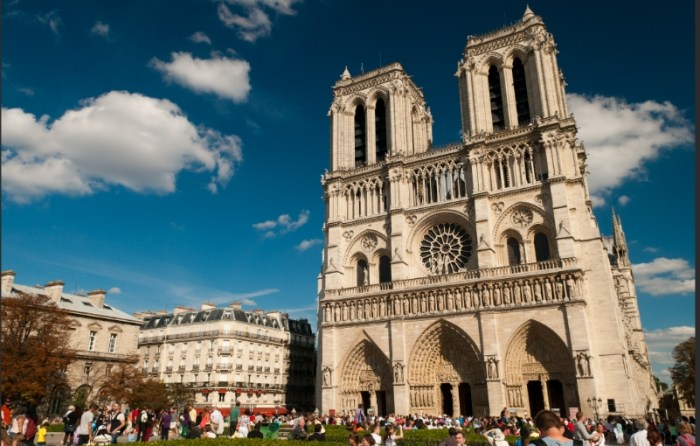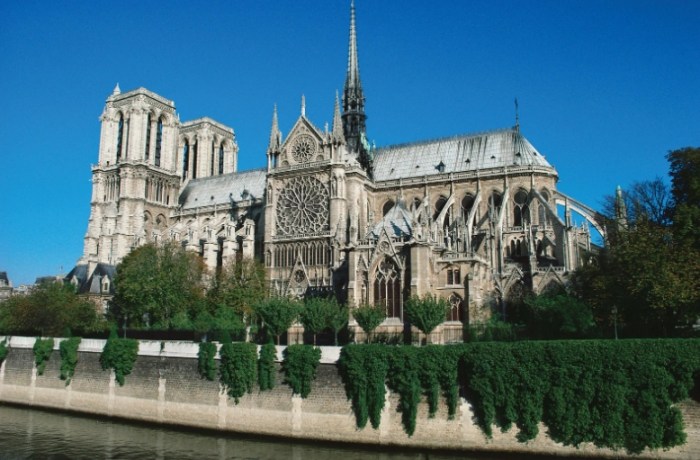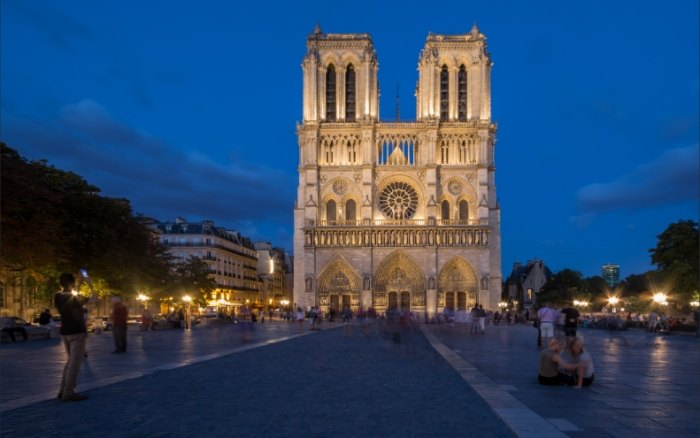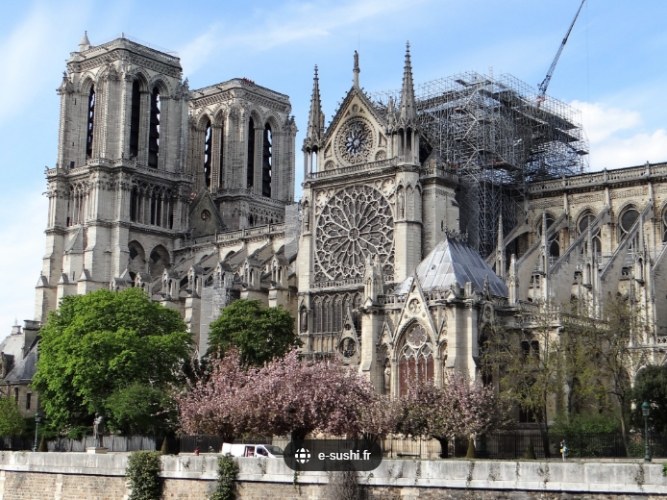Notre Dame de Paris: 800 Years of Gothic Architecture & History
Advertisements
Ever marveled at the Gothic splendor of Notre Dame de Paris? Explore 850 years of history at this iconic cathedral—from its flying buttresses and rose windows to Victor Hugo's literary legacy. Witness the 2019 fire's aftermath and ongoing restoration, while uncovering secrets of its medieval construction, Quasimodo's fictional home, and surviving relics like the Crown of Thorns. Plan your visit to this UNESCO World Heritage Site at the heart of Parisian culture!
Table of Contents
- I. Historical Background of Notre Dame de Paris
- II. Cultural Significance and Features
- III. Natural and Humanistic Landscapes Around Notre Dame
- IV. Practical Information for Visitors
- V. Special Events and Activities
- VI. Accommodation Recommendations
- VII. Culinary Delights Near Notre Dame
- VIII. Tips and Considerations for Visitors
- IX. Q&A: Answers to Common Questions
As a lifelong resident of Paris, I have witnessed the evolution of Notre Dame de Paris, the crown jewel of our city's architectural heritage. This iconic cathedral, standing proudly on the Île de la Cité in the heart of Paris, is not just a religious monument but a living testament to centuries of French history, culture, and artistry. In this comprehensive guide, I will share my insights into this magnificent structure, offering both historical context and practical information for visitors.
I. Historical Background of Notre Dame de Paris

Origins and Construction
- Foundation and Architectural Vision: The story of Notre Dame begins in the 12th century, when Bishop Maurice de Sully envisioned a grand cathedral to replace the aging Saint-Étienne Basilica. Construction commenced in 1163 under the reign of King Louis VII and Pope Alexander III, taking nearly two centuries to complete.
- Gothic Style: Notre Dame is a quintessential example of French Gothic architecture, characterized by its pointed arches, ribbed vaults, and flying buttresses. These elements not only provided structural support but also allowed for larger windows, filling the interior with light.
Historical Milestones
- Coronation of Kings: Over the centuries, Notre Dame served as the coronation site for French monarchs, including Henry VI of England in 1431 and Napoleon Bonaparte in 1804.
- Literary Inspiration: Victor Hugo's 1831 novel, "The Hunchback of Notre Dame," brought international attention to the cathedral, highlighting its cultural significance and prompting restoration efforts in the mid-19th century.
- 2019 Fire: A devastating fire in April 2019 caused significant damage to the cathedral's roof and spire. Restoration work is ongoing, with plans to reopen parts of the cathedral to the public in the coming years.
II. Cultural Significance and Features

Architectural Marvels
- Facade and Portals: The west facade, adorned with intricate sculptures and three grand portals, is a masterpiece of Gothic artistry. The Portal of the Last Judgment, the Portal of the Virgin, and the Portal of Saint Anne each depict biblical scenes and saints.
- Rose Windows: The cathedral's three rose windows, particularly the south rose window, are renowned for their vibrant stained glass, which dates back to the 13th century. These windows depict scenes from the Book of Genesis, the Life of Christ, and the Last Judgment.
- Towers and Gargoyles: The twin towers, standing at 69 meters (226 feet) tall, offer panoramic views of Paris. The gargoyles, while primarily decorative, also serve as rain spouts, showcasing the practicality of Gothic design.
Religious and Cultural Importance
- Religious Services: Notre Dame remains an active place of worship, hosting daily Masses and special religious ceremonies. Visitors are welcome to attend services, offering a glimpse into the cathedral's spiritual life.
- Cultural Events: The cathedral frequently hosts concerts, exhibitions, and other cultural events, celebrating its role as a cultural hub of Paris.
III. Natural and Humanistic Landscapes Around Notre Dame

Île de la Cité
- Square Jean XXIII: Located just east of Notre Dame, this peaceful square offers a tranquil retreat from the bustling city. It features a beautiful garden and a view of the Seine River.
- Pont Neuf: The oldest bridge in Paris, Pont Neuf spans the Seine, connecting the Île de la Cité to the Left and Right Banks. Strolling across the bridge provides stunning views of Notre Dame and the city skyline.
Nearby Attractions
- Sainte-Chapelle: A short walk from Notre Dame, Sainte-Chapelle is another Gothic masterpiece, known for its exquisite stained glass windows depicting biblical stories.
- Conciergerie: Once a royal palace and later a prison, the Conciergerie offers a glimpse into France's turbulent history, including the Reign of Terror during the French Revolution.
IV. Practical Information for Visitors
Operating Hours
- Current Status: Due to ongoing restoration work, the interior of Notre Dame is currently closed to the public. However, the exterior remains accessible, and visitors can still admire the facade, towers, and surrounding gardens.
- Future Reopening: While an exact date has not been set, officials aim to reopen parts of the cathedral, including the crypt and certain chapels, in the coming years. It is advisable to check the official website for the latest updates.
Ticket Prices and Reservations
- Admission Fees: Currently, there is no admission fee to view the exterior of Notre Dame. However, when the interior reopens, there may be a nominal fee for entry.
- Guided Tours: Guided tours of the cathedral, when available, offer in-depth insights into its history, architecture, and cultural significance. These tours can be booked in advance through the official website or at the cathedral's information desk.
Transportation Routes
- Metro: The closest metro stations to Notre Dame are Cité (Line 4) and Saint-Michel (Lines 4 and RER B).
- Bus: Several bus lines, including 21, 24, 27, 38, 47, 85, and 96, stop near the cathedral.
- Bicycle: Paris's Vélib' bike-sharing system provides a convenient way to explore the city. Bike racks are available near Notre Dame.
Best Time to Visit
- Seasonal Considerations: Spring and fall offer mild weather and fewer crowds, making them ideal times to visit. Summer can be hot and crowded, while winter may be cold but provides a unique, serene atmosphere.
- Day vs. Night: Visiting Notre Dame at night, when it is illuminated, offers a magical experience. However, note that the exterior may be closed to the public after a certain hour.
V. Special Events and Activities
Annual Celebrations
- Christmas Mass: Notre Dame hosts a special Christmas Mass, drawing thousands of worshippers and visitors. The cathedral's interior is beautifully decorated, creating a festive atmosphere.
- Easter Services: Easter is another significant religious occasion at Notre Dame, with special services and processions.
Cultural Festivals
- Fête de la Musique: On June 21st, Paris celebrates the Fête de la Musique, with free concerts and performances throughout the city. Notre Dame often hosts special events as part of this festival.
- Paris Plages: During the summer months, the banks of the Seine are transformed into urban beaches, offering a unique way to enjoy the city. Visitors can relax near Notre Dame and soak up the sun.
VI. Accommodation Recommendations
Luxury Hotels
- Hôtel de Crillon: Located just a short walk from Notre Dame, this historic luxury hotel offers elegant rooms, exceptional service, and stunning views of the city.
- Shangri-La Hotel, Paris: Situated on the Left Bank, this five-star hotel combines French elegance with Asian hospitality, providing a luxurious stay near Notre Dame.
Mid-Range Options
- Hôtel du Jeu de Paume: This charming boutique hotel, housed in a 17th-century building, offers comfortable rooms and a central location near Notre Dame.
- Hôtel des Deux Îles: Nestled on the Île Saint-Louis, this hotel provides a peaceful retreat while remaining within easy reach of Notre Dame and other attractions.
Budget-Friendly Choices
- Hôtel de la Bretonnerie: Located in the Marais district, this cozy hotel offers affordable rooms and a friendly atmosphere, making it a great option for budget-conscious travelers.
- Hôtel des Arts Montmartre: While slightly farther from Notre Dame, this hotel in Montmartre offers affordable rates and a vibrant neighborhood atmosphere.
VII. Culinary Delights Near Notre Dame
Traditional French Cuisine
- Le Procope: Paris's oldest café, Le Procope offers classic French dishes in a historic setting. Try the coq au vin or boeuf bourguignon for an authentic taste of France.
- Chez L'Ami Jean: This Basque-inspired bistro serves hearty, flavorful dishes, such as duck confit and piperade. The cozy atmosphere and friendly service make it a local favorite.
Cafés and Bakeries
- Café de Flore: While not directly near Notre Dame, this iconic café on the Left Bank is worth a visit for its rich history and delicious pastries. Enjoy a café au lait and a croissant while soaking up the atmosphere.
- Du Pain et des Idées: This bakery, located in the 10th arrondissement, is renowned for its artisanal bread and pastries. The escargot aux pommes (apple snail pastry) is a must-try.
Street Food and Markets
- Marché des Enfants Rouges: Paris's oldest covered market, located in the Marais, offers a variety of street food options, from Moroccan tagines to Japanese sushi.
- Rue Cler: This pedestrian street on the Left Bank is lined with food shops, cafés, and restaurants, providing a taste of Parisian life.
VIII. Tips and Considerations for Visitors
Respectful Attire
- When visiting Notre Dame, especially for religious services, it is important to dress modestly. Avoid wearing shorts, tank tops, or revealing clothing.
Photography Etiquette
- While photography is generally allowed on the exterior of Notre Dame, it is important to be respectful of worshippers and other visitors. Avoid using flash photography inside the cathedral, when it reopens, and be mindful of your surroundings.
Safety and Security
- Paris is generally a safe city, but it is always wise to be vigilant, especially in crowded areas. Keep your belongings secure and be aware of your surroundings.
Accessibility
- Notre Dame is partially accessible to visitors with disabilities. However, due to ongoing restoration work, some areas may be temporarily inaccessible. It is advisable to contact the cathedral in advance for specific accessibility information.
IX. Q&A: Answers to Common Questions
1. Can you still visit Notre Dame in Paris?
- Answer: Yes, visitors can still admire the exterior of Notre Dame de Paris. The facade, towers, and surrounding gardens remain accessible, offering a glimpse into the cathedral's grandeur. However, the interior is currently closed to the public due to ongoing restoration work following the 2019 fire.
2. Can you just walk into Notre Dame?
- Answer: Currently, the interior of Notre Dame is not open to the public. When it reopens, visitors will likely be able to enter during specified hours, although there may be restrictions on certain areas due to restoration work. It is advisable to check the official website for the latest information on visiting hours and guidelines.
3. What is the current status of Notre Dame Cathedral?
- Answer: Notre Dame de Paris is undergoing extensive restoration work following the 2019 fire. The exterior has been stabilized, and efforts are focused on repairing the roof, spire, and interior. While the exact timeline for completion is uncertain, officials aim to reopen parts of the cathedral to the public in the coming years.
4. Why is Notre-Dame de Paris so famous?
- Answer: Notre-Dame de Paris is famous for several reasons:
- Architectural Masterpiece: As a prime example of French Gothic architecture, it showcases innovative design elements, such as pointed arches, ribbed vaults, and flying buttresses.
- Historical Significance: The cathedral has played a central role in French history, serving as the coronation site for kings and a setting for significant cultural events.
- Literary and Cultural Icon: Victor Hugo's novel, "The Hunchback of Notre Dame," brought international attention to the cathedral, cementing its place in popular culture.
- Spiritual Center: Notre Dame remains an active place of worship, hosting daily Masses and special religious ceremonies, attracting pilgrims and worshippers from around the world.
In conclusion, Notre Dame de Paris is more than just a cathedral; it is a symbol of Paris's rich history, culture, and artistry. Whether you are a history enthusiast, an architecture lover, or simply seeking a glimpse into the heart of Paris, a visit to Notre Dame is an unforgettable experience. As a local, I encourage you to explore this magnificent structure and discover the stories it holds within its walls.
About the author:My name is Chloe, a lifelong Parisian with an insatiable passion for sharing the magic of la belle France. Through this blog, I’ll take you beyond the postcard clichés to uncover the soul of France—its riveting history, hidden-gem destinations, decadent cuisine, and the art de vivre that makes this country unforgettable. Whether you’re planning a trip, a foodie craving authentic recipes, or a culture enthusiast, join me as we explore everything from cobblestone villages to haute couture boutiques.
Advertisements